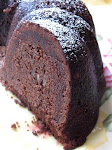 I love apricots in baked goods...there is just something so delightful in finding bits of dark golden sweetness in a scone or muffin or sweet bread.
I love apricots in baked goods...there is just something so delightful in finding bits of dark golden sweetness in a scone or muffin or sweet bread.The aroma is also enticing and the sweet-tart taste is sublime.
In honor of Bread Baking Day # 18 - Quick Breads, hosted by Mansi at Fun and Food Blog, http://funnfud.blogspot.com/2009/03/announcing-bbd18-quick-breads.html , I made an Apricot Almond Sweet Bread. This is a type of quick bread, which is called quick because the leavening isn't my beloved yeasties, but instead is a chemical reaction between acids and bases. In this case I mixed two recipes from the Fannie Farmer Baking Book by Marion Cunningham; a Poppy Seed Bread and an Apricot Almond Bread.
In honor of Bread Baking Day # 18 - Quick Breads, hosted by Mansi at Fun and Food Blog, http://funnfud.blogspot.com/2009/03/announcing-bbd18-quick-breads.html , I made an Apricot Almond Sweet Bread. This is a type of quick bread, which is called quick because the leavening isn't my beloved yeasties, but instead is a chemical reaction between acids and bases. In this case I mixed two recipes from the Fannie Farmer Baking Book by Marion Cunningham; a Poppy Seed Bread and an Apricot Almond Bread.
From the first I took the proportions for using buttermilk, butter and eggs for the quick bread, including how much baking powder and baking soda to use. From the second I took the proportions for the apricots, almonds, and almond extract. I also followed the directions for mixing from the first one.
This recipe makes two loaves which are on the sweet side, perfect to go with your afternoon cup of tea or coffee (or ice cold milk!). Xam had a good time licking the bowl.
When the bread is still in the oven and you see the enthusiasm with which the bowl is being licked, it's hard to wait until that bread is both baked and cooled enough to cut!

Apricot Almond Quick Bread
based on two recipes in the Fannie Farmer Baking Book by Marion Cunningham
3 cups all-purpose flour
1 teaspoon baking powder
1 1/2 teaspoons baking soda (the base)
1 teaspoon salt
1/4 teaspoon ground nutmeg (my addition)
2 eggs
1 cup sugar
1 1/2 cups buttermilk (the acid)
1/2 cup butter, melted and cooled (my substitution)
1/2 teaspoon almond extract
1 cup dried apricots, diced (about 8 pieces per dried apricot half)
1/2 cup chopped almonds
Preheat the oven to 350 degrees F. Butter and flour two 8 1/2 by 4 1/2 by 2 1/2 inch loaf pans. Set aside.
Mix together in a bowl the flour, baking powder, baking soda, salt, and nutmeg. Set aside.
In a large mixing bowl, combine the eggs, sugar, buttermilk, melted butter and almond extract. Add the dry ingredients and mix just to blend. Don't over mix. Stir in the apricot pieces and chopped almonds and stir just until incorporated.
Pour batter into the two loaf pans, distributing evenly.
Bake for about 45 minutes, or until a tester comes out clean.
Remove from the oven and let cool for about 5 minutes, then turn out onto a rack to cool completely.
This bread makes a nice gift so keep this in mind for birthdays, Easter, Christmas, etc.
































